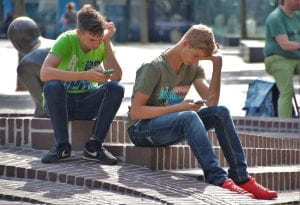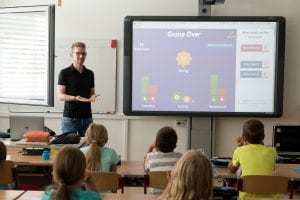“In a world where the online and offline are increasingly blending, to what extend should we emphasise the role of the ‘digital’ in ‘digital citizenship’?” (Cortesi et al 2020, p. 4)
Write a blog post using the prompt: Is digital citizenship still the best terminology to use?

Credit: Natureaddict
Before exploring the term ‘digital citizenship’, it is prudent to consider what we mean by citizenship and why it’s important.
To be a citizen is to bear certain rights and responsibilities – it is the ‘responsibilities’ – or boundaries (Öztürk, 2021, p. 32) – part that people tend to forget, or overlook, while focusing on their ‘rights’, or privileges, as citizens. These include “being respectful and polite, responsible and making positive contributions to the society” (Öztürk, 2021, p. 32). Öztürk points out that it is the community that is at the heart of citizenship, not the individual.
Kershaw (2004) points out that the concept of citizenship became a focus in the 1990s – which coincides with the home computer and the early mobile phones, then the ‘arrival’ of the world wide web – including Google, email, online chat forums and, later, Facebook. He refers to an “alleged decline” in “civic-spiritedness” (2004, p. 1) which aligns with Ribble’s ideas of digital citizenship: treating others “with empathy and understanding both on and offline” (2015, p. 13). I don’t mean to suggest that the advent of digital technology in the home and school caused a decline in being of good character, but that the decline in good character which Kershaw (2004) refers to was – and is – felt in the online sphere, too. However, it can easily be seen that digital technologies, and the apps and programs accessed with them, have exacerbated the problem.
Ribble (2004) argues for the need to teach ‘character’: that is, being a good person who treats others well, and kindly. Their ‘nine elements’ (pp. 15-17) go further than just being ‘good’ and ‘kind’: they embrace the full scope of what it means to be a citizen of a society, in this case an online one. For instance, Element 1: Digital Access, is about equity, which in our intensely capitalist world is sorely lacking. Reading the list of nine elements, I can see that each one is relevant and necessary.
We used to learn how to write a letter with ‘correct’ formatting, salutations, structure and form, to ensure smooth, open and respectful dialogue. Digital technologies are here to stay but somehow, in our increasingly crowded curriculum, the teaching of how to use it ethically, responsibly and with kindness, didn’t eventuate. It’s not the same as passively watching the telly; as Ribble (2004) points out, digital technologies allow us to be producers, as well as consumers, of information, and the ‘real’ world and the online one have become the same (p. 12).
The Covid-19 pandemic puts digital citizenship into a new, stark context: as Buchholz, Dehart & Moorman (2020) point out, the lockdowns both showed the importance of citizenry – acting with responsibility for a greater good – as well as the need for digital literacy – finding the authentic, accurate information in a sea of online misinformation. Digital citizenship is more than digital etiquette (as important as that is); it is also the ability to use technology wisely (Öztürk, 2021, p.34). The pandemic showed us many things, including the sad reality that we were unprepared technologically, and that we have issues of equitable access. As more and more Australians succumb to online shopping scams (okay so I will put my own hand up here, as embarrassing as that is!), it is clear that there are serious gaps in our knowledge and ability to use technology safely, as well as respectfully. As I read more in Module 1, I find myself surprised at how we are not even taking this seriously, as a society, in Australia – for adults as much as young people.
Like language, we’re not born knowing politeness, understanding or respect, but as with language, we are born with the capacity to learn it. Parents know they have to teach their children to be polite and respectful, and they have to model it – it is the same with digital technology. I don’t think the term is out-of-date at all. ‘Digital’ still encompasses a broad range of things, from the technological tools themselves – from the cloud to a tablet to a mobile phone, its camera and microphone – to the online platforms accessed with them. I wouldn’t be surprised if a new term emerges in the next 5-10 years, because language evolves, but ‘digital’ still seems to cast a wide-enough net.
References
Buchholz, B. A., Dehart, J., & Moorman, G. (2020). Digital citizenship During a global pandemic: Moving beyond digital literacy. Journal of Adolescent & Adult Literacy, 64(1), 11-17. https://primo.csu.edu.au/permalink/61CSU_INST/15aovd3/cdi_pubmedcentral_primary_oai_pubmedcentral_nih_gov_7405058
Cortesi, S., Hasse, A., Lombana-Bermudez, A., Kim, S., & Gasser, U. (2020). Youth and digital citizenship+ (plus): Understanding skills for a digital world. Youth and Media, Berkman Klein Center for Internet & Society. https://dx.doi.org/10.2139/ssrn.3557518
Kershaw, P. (2004). Carefair: Rethinking the responsibilities and rights of citizenship. UBC Press. https://ebookcentral.proquest.com/lib/csuau/reader.action?docID=3412035&ppg=1
Öztürk, G. (2021). Digital citizenship and its teaching: A literature review. Journal of Educational Technology and Online Learning, 4(1), 31-45. https://primo.csu.edu.au/permalink/61CSU_INST/15aovd3/cdi_proquest_journals_2844067431
Ribble, M. (2015). A brief history of digital citizenship. In Digital citizenship in schools: Nine elements all students should know (3rd ed., pp. 9-14). International Society for Technology in Education. https://search-ebscohost-com.ezproxy.csu.edu.au/login.aspx?direct=true&db=nlebk&AN=1072357&site=ehost-live&ebv=EB&ppid=pp_17



















Recent Comments
shannon.badcock
"Yes I wondered/worried about that. I find it hard to separate it from ..."
ederouet
"What a great looking blog! I love your widgets and use of categories ..."